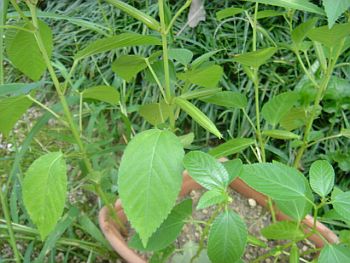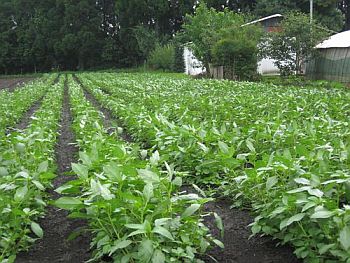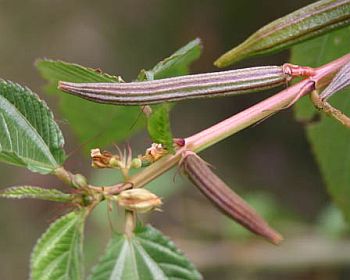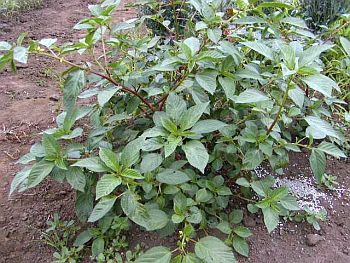Popeye Did Not Know Egyptian Spinach Called Molokhiya
Since 1964, I have been eating Egyptian spinach almost every day during my travels in Malaysia, Thailand, Vietnam, and Philippines. Japan started to plant molokhiya sometime in 1980 for Japanese daily vegetable consumption especially in Miyagi prefecture. Today it has spread all over Japan, and you can now find it in all vegetable and convenience stores, including its seed for hobbyists to plant in their small backyard garden.
One may encounter many different transliterations for the Arabic word molokhiya, such as mulukhiya and molokhia. It is also called jute, Egyptian spinach, Jews mallow, Jute mallow, or saluyot, with a scientific name of Corchorus olitorius.

According to some internet sources, molokhiya means vegetable for King. During 6000 BC, a sick Egyptian King asked a bowl of hot soup, and found it tasty. After taking hot soup every day, the King's illness was healed. Cleopatra also enjoyed the same soup. The soup was the Egyptian spinach called molokhiya. We believe that this miracle vegetable originated in India and Egypt.
Molokhiya is known as the king of vegetables. Its carotene contents are 4.6 times more than spinach, which Popeye loved, and 19 times more than broccoli. Its calcium contents are 9 times more than spinach and 10 times more than broccoli. Even vitamins B1 and B2 are five times more compared to spinach. It contains much more Vitamin E, C, potassium, iron, and other vegetable fibers than any other vegetables.

Molokhiya possesses properties that can boost our immune system to help prevent cancer, premature aging, osteoporosis, fatigue, high blood pressure, and anemia. Its vitamin contents moisturize our skin and make it soft and smooth, and resist early aging. Egyptian spinach is considered demulcent, diuretic, febrifuge and tonic.
In addition, the molokhiya's viscous texture is rich in soluble fiber. This dietary fiber has a cholesterol-lowering effect, relieves constipation, and prevents obesity and diabetes, including colorectal cancer and other lifestyle-related diseases.
Aside from these medicinal effects we know now, we are coming up in discovering more and more of its amazing health effects.
Green young leaves are used as vegetables just like okra or spinach, and are a good source of vitamins and other abundant nutrients. Dried leaves are used as soup thickener or jute tea.

I myself have planted molokhiya in my backyard garden. I'm planting about 20 seeds every 6 months, which is good enough for daily consumption of my family. In my farm in the countryside, even though we do not plant it, wild molokhiya grows in thousands every now and then throughout the year.
100 grams of Molokhiya leaves contains:
Carotene - 10,000 µg
Calcium - 500 mg
Potassium - 650 mg
Iron - 3.8 mg
Vitamin B1 - 0.24 mg
Bitamin B2 - 0.76mg
No wonder, our caretakers in my farm as well as their neighbors are very healthy. Most of them live over 83–103 years old. In fact, three of them are 101, 102 and 103 years old, and are still active. Probably, my family and I are in good health because of the Egyptian spinach? So healthy that we might not need the PYRO-ENERGEN, ha ha ha.
We are very glad of this miracle and mysterious vegetable that was introduced to Japan from Egypt.
If you are worried about cholesterol contents in your blood and high blood symptoms, take moloheiya starting today.
You can find hundreds of molohiya recipe on the net. Whether it's for beauty and to prevent premature aging and to keep your skin healthy...no wonder, Cleopatra loved to eat Moloheiya. I personally recommend you to take this.

Also read articles “Food Shortage? Who Said So?” and “Moringa Oleifera (Horseradish Tree) as an Eco-friendly Solution”.
Reprint Rights: You may reprint this article within your website, blog, or newsletter as long as the entire article remains the same as well as the “About the Author” box.



 Junji Takano is a Japanese health researcher involved in investigating the cause of many dreadful diseases. In 1968, he invented PYRO-ENERGEN, the first and only electrostatic therapy machine that effectively eradicates viral diseases, cancer, and diseases of unknown cause.
Junji Takano is a Japanese health researcher involved in investigating the cause of many dreadful diseases. In 1968, he invented PYRO-ENERGEN, the first and only electrostatic therapy machine that effectively eradicates viral diseases, cancer, and diseases of unknown cause.


